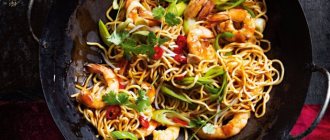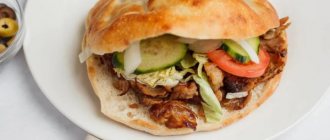What it is
Udon noodles are traditional Japanese noodles made from wheat flour. The word “udon” comes from the name wontons, Chinese dumplings with various fillings. In popularity it is second only to the famous Japanese rice.
What does it consist of?
Udon noodles are a mixture of wheat flour, salt, and water.
Energy value of the product:
- proteins - 10.4 grams;
- fats - 1.1 grams;
- carbohydrates - 69.7 grams.
Calorie content: 337 Kcal.
Benefits and harms
Before eating any product, you need to learn about its benefits and harm. Like any other dish, udon has both beneficial properties and various contraindications. But unlike its beneficial properties, it has practically no contraindications. It can be eaten by everyone.
Benefit:
- Due to the content of complex carbohydrates in its composition, it promotes weight loss.
- Prevention of cardiovascular diseases.
- Prevents the occurrence of type 2 diabetes mellitus and also helps in its treatment.
- The noodles are quite easy and quick to digest.
- Strengthens the immune system due to the content of plant fiber.
- Contains vitamins B1 and B3.
- Eating dishes made from these noodles helps with stress and nervous exhaustion.
Harm:
There are no special contraindications for eating udon dishes. The only thing you need to remember is that it is made from wheat flour, which contains a certain amount of gluten. People trying to follow a gluten-free diet should avoid eating noodle-based foods.
Did you know that you can cook delicious baked goods in the microwave? Here is a small selection of microwave charlotte recipes with different fillings.
Read how to cook an incredibly delicious casserole with cottage cheese and pumpkin.
Take note of the recipe for delicious pea puree cooked in the microwave.
What does Japanese udon noodles look like?
Udon is a pasta product that consists of long and thick threads with a diameter of 2-4 millimeters. The color of the noodles may vary. It depends on what kind of flour is used to prepare it.
Photo: udon noodles in a package
Udon is considered a type of Japanese fast food and has several varieties, of which the most popular are:
- Mimi-udon. It is prepared in the Kanto region, where the capital of Japan, Tokyo, is located.
- Khoto. Externally it looks like wide and thin strips of dough. Produced in Chubu. Prepared and served with vegetables and pumpkin.
- Ise-udon. Thick but tender, soft-textured noodles produced in the Kinki region.
- Kansai udon. Medium sized soft noodles. Distributed in the region of western Japan on the island of Honshu.
- Kishiman. Flat noodles. Homeland - Nagoya.
- Sanuki. It differs in thickness and hardness.
- Inaniwa-udon. Thin noodles. The place where it is produced is called Akita Prefecture. Located in the northern part of Japan.
Green onions, soy sauce, tempura, shrimp, tofu, kamabako, and rice vinegar are traditionally added to udon noodles.
The broth and additives depend on the region in which the noodles are prepared.
Ramen vs Udon Noodles: Best Brands
Best Ramen Brands
When it comes to choosing a brand of ramen noodles, there are many options.
Here are some of our top picks:
- Samyang Ramen Spicy Fried Chicken Noodles come with spaghetti style noodles and a fantastic spicy sauce.
- Nongshim Shin Spicy Ramen is made with a savory beef broth and comes in a gourmet cup, perfect for when you're on the go.
- Cup Nissina Ramen is an authentic creamy noodle soup served with squid, imitation crab, fried egg and cabbage.
- Lotus Foods Millet and Brown Rice Ramen is flavored with miso and a great gluten-free alternative.
- Nisshin Top Ramen has a soy sauce flavor and is suitable for vegetarians.
Difference from somen, ramen and soba noodles.
Soba is a Japanese noodle made from buckwheat flour and water, sometimes with wheat flour and green tea. This is the main difference from udon noodles.
Photo: soba noodles
Soba has a great advantage over all types of noodles made from wheat flour - it is dietary. The amount of fat in its composition is 0.9 grams.
Somen is prepared in the same way as udon using wheat flour. The only difference is that the diameter of the somen is 0.4 millimeters smaller.
Photo: somen noodles
The ramen noodle dough is made from four ingredients: eggs, wheat flour, water and salt. There are no eggs in udon (Attention!). This is the main difference.
Photo: ramen noodles
The origin of these noodles is interesting. There are numerous legends and speculations about this. One version says that udon appeared in Japan thanks to the traveling Buddhist priest Kukai.
Upon his return from China, he passed on the recipe to his neighbors who lived in what is now Kagawa, Japan. This type of pasta became popular in the 17th-19th centuries.
Types of noodles
This product consists of long narrow strips of dough, which is made from rice or wheat flour and kneaded in water. Egg noodles have a different composition, which includes eggs or egg powder. Each type of product has its own characteristics. Let's try to figure out how noodles differ from regular pasta and which type is the healthiest.
Egg
Asian noodles are not similar to other pasta products even in appearance. Its miniature size immediately catches your eye: these are flat strips 1 mm wide. The recipe includes the simplest ingredients - water, eggs or egg powder, salt. Flour (usually wheat) is also added to balance the taste and increase nutritional value. If yolks are used for production, the color of the product becomes rich yellow, if only the whites - grayish or translucent.
Egg noodles are considered the tastiest and healthiest when they are prepared without the use of liquid. Its nutritional value is as follows (per 100 g of dry product):
- calorie content – 304 Kcal;
- proteins – 14.16 g;
- fats – 4.44 g;
- carbohydrates – 67.97 g;
- cholesterol – 84 mg;
- ash – 1.12 g;
- water – 9.01 g.
The product is rich in vitamins D, A, group B and nicotinic acid, and it also has a good nutrient composition: potassium, magnesium, phosphorus, iron, zinc.
Natural egg noodles fit perfectly into the concept of a healthy diet. It is not for nothing that it is highly valued in the cuisines of different countries, because in moderation it really benefits the body:
- normalizes the functioning of the gastrointestinal tract;
- regulates blood sugar and cholesterol levels;
- saturates the body with vitamins, micro- and macroelements, as well as easily digestible proteins;
- provides a feeling of fullness for several hours, charging you with energy and strength for work.
If premium flour, starch, thickeners, preservatives, and flavor enhancers were used for cooking, this is already gastronomic garbage - perhaps tasty, but such a product cannot be called healthy. To be sure of the benefits and quality of noodles, you can prepare them at home. Spices will help add additional flavor notes and will also replace table salt. The dish goes well with vegetables, fish and meat side dishes. Such food will provide high-quality satiety until the next meal.
Wheat
This is one of the most popular types of pasta. Everyone knows the taste of wheat noodles, and the production technology and recipe do not require high costs. The undisputed leader in product consumption is Japan. In this country, people have eaten wheat noodles every day for centuries. It is included in most traditional Asian dishes in combination with various sauces and additives.
There are 2 main varieties of the product - ramen and udon, which was originally prepared by the Chinese, but later it moved into Japanese cuisine. A distinctive feature of the product is the absence of eggs in its composition. Udon is also considered the thickest noodle, its diameter ranges from 2 to 4 mm. The consistency is soft and elastic, the shade is white or grayish.
Energy value and composition:
- calorie content – 337 Kcal;
- proteins – 10.4 g;
- fats – 1.1 g;
- carbohydrates – 69.7 g;
- fiber – 3.2 g;
- cholesterol – 143 mg;
- ash – 3 g;
- saturated fatty acids – 0.9 g;
- starch – 59.8 g.
The product contains a high content of vitamins A, E, PP, beta-carotene, and also minerals - potassium, calcium, sodium, phosphorus.
Udon is traditionally served as a soup, pouring meat, vegetable or fish broth, adding green onions, soy sauce, and shrimp. The dish is eaten cold. This food is ideal for hot weather. It helps to cool down and at the same time satisfies hunger perfectly.
Ramen differs from udon in color, composition and method of serving. When kneading the dough, eggs are added to it, and they are also added to the finished soup. Ramen is served hot with various spices and additional ingredients - vegetables, seafood.
The benefit of wheat noodles is their high fiber content. This plant component is not absorbed by the body, but supports its basic functions. Wheat contains soluble fiber, which turns into a liquid gel in the stomach. It gently envelops the internal organs and gives them additional protection. Fiber has other beneficial properties:
- maintaining optimal blood sugar and cholesterol levels;
- normalization of intestinal function;
- providing a long-lasting feeling of satiety;
- improvement of skin condition;
- normalization of internal microflora (this has a positive effect on performance and appearance);
- prevention of breast and intestinal cancer;
- easier to wake up in the morning.
You can increase the benefits of the product by adding additional components:
- Easily digestible carbohydrates - vegetables, fruits.
- Proteins – lean meat and fish, legumes.
- Healthy fats - vegetable oils, avocados, nuts.
Regular consumption of wheat noodles has a positive effect on the functioning of the nervous system. The grain is rich in B vitamins, which are natural antidepressants: they eliminate anxiety and normalize the psycho-emotional state. Therefore, it is useful to eat the dish after work to relax and relieve stress.
Interesting fact: the creator of Zen Macrobiotics, J. Ozawa, divides all foods into Yin and Yang. Depending on the polarity, one food improves health, while the other provokes serious disruptions in the functioning of the body and various diseases. In the author’s classification, wheat noodles belong to the Yang category - they are maximally useful and can minimize the harm from Yin products.
Rice
Video: Rice noodles. Asian cuisine
Rice noodles are a classic Asian product made from rice flour. This is a favorite dish of the Japanese and Chinese, consisting of long strips of white dough with a grayish tint. Their thickness varies from 2 mm to 3 cm, and their length can reach 50 cm. Rice noodles have a mild taste, a subtle aroma with notes of beans and nuts, and they are also very filling. Many consider funchose to be its variety, but this type of pasta is made from beans. When cooked, the funchose remains transparent, and the rice noodles turn white.
Interestingly, in Asia they try to make homemade rice noodles as long as possible. According to an Eastern proverb, its length symbolizes life expectancy.
Calorie content of 100 g of rice noodles – 364 Kcal. It consists of 75% starch, so its nutritional value is high. The remaining 25% is:
- vitamins PP and group B;
- minerals: calcium, potassium, iron, selenium, zinc, phosphorus;
- saturated fatty acids;
- amino acids, including tryptophan, arginine, valine, tyrosine;
- some fiber.
No harmful properties have been identified in rice noodles, but there are benefits from its consumption. The large amount of starch in its composition ensures quick saturation, since this ingredient envelops the stomach. It does not provoke weight gain.
Since the product does not contain salt, it is suitable for a diet menu for diseases of the kidneys, heart and blood vessels. The high content of minerals has a positive effect on the functions of the entire body and the condition of internal organs.
Unlike wheat noodles, rice noodles contain virtually no fiber, making them easier to digest by the body. Therefore, the dish is recommended for children and the elderly.
Other beneficial properties of rice noodles:
- strengthening the nervous system;
- improving memory and attention;
- cleansing blood vessels;
- activation of metabolic processes;
- providing the body with energy;
- improvement of cellular regeneration and brain function;
- slowing down the aging process.
How to cook noodles
There is nothing complicated about cooking udon. For this operation you only need to take noodles, water, a saucepan and a little vegetable oil:
- Step 1: Pour water into a saucepan, place the amount of noodles that will be necessary for consumption or cooking with any additives.
- Step 2: Bring to a boil. Cook for 5 - 10 minutes.
- Step 3: Place in a colander and sprinkle with oil.
Attention! If, after boiling the noodles, manipulations are carried out (frying, stewing, etc.), you need to leave them slightly undercooked.
Types of Japanese noodles – melon_panda – LiveJournal
I’m obsessed with somen noodles (thanks, a friend reminded me of it), I’m ready to eat them every day - light, refreshing, with ice cubes in a bowl, just the thing for weather in which even new air conditioners can’t handle it. I’ve written about noodles more than once, both about ramen and about soba, but I decided to write again, to collect all types of Japanese noodles in one place - you never know, maybe it will come in handy for someone, especially since there is sometimes some confusion in European recipes. And what’s interesting is that Japanese somen, I remembered, was somehow sold here in Chita in the 90s, but then, of course, we didn’t know that it was somen, and we cooked what you might think was milk soup with it. The soup was delicious. Therefore, in the description of each type, I will write a gag - with what non-canonical Japanese cuisine, in my opinion, the noodles are combined.
With somen
and let's begin. It's written like this
or so
Most often they eat it cold (although there is some kind of winter dish), very cold. The noodles are cooked for 2-3 minutes and then washed with cold water. Served with ice water or tsuyu - a broth based on dashi, mirin and soy sauce (this is not our broth, there is no meat, vegetables or fat). Somen is very thin and tastes salty, unlike other noodles. These noodles are very beautiful to serve, especially when they are boiled in a bunch and then beautifully arranged in “one strand”. Not found fresh, sold dry. It goes great with milk; if you don’t have Japanese broth, you can try what cold soups are usually made from, it should be good. Or without liquid at all, but with seafood.
Ramen
. It's written like this
Essentially, egg noodles are dense, elastic, and sometimes slightly curly. It can be a little thinner, a little thicker, with a round or square cross-section. In Japanese stores it is often sold fresh in the refrigerated food section, which suggests that it is not dry enough. With these noodles they make the world-famous hot ramen with broth, which has a hundred thousand variations. In addition, there is zaru ramen - this is when the noodles are boiled, cooled, folded and served in a heap. In this case, it should be consumed like this: take it with chopsticks, dip it into a glass of tsuyu (see above), in which a little wasabi and green onions are mixed, and immediately into the mouth. Ramen can be used in liquid hot dishes in an oriental style, with some duck or chicken broth, mushrooms, etc.
Soba
- noodles made from buckwheat flour. It's written like this
Recipe without additives
Ingredients:
- wheat flour of different varieties - 650 grams;
- water - 250 milliliters;
- salt - 30 grams.
Preparation:
- Dissolve salt in hot water.
- Mix salted and plain water with flour.
- Knead the dough, roll it into a ball. Wrap in film and cloth and place on the floor.
- Start striding vigorously over the lump until it turns into a cake.
- Then roll out the dough, fold it in half and repeat the rolling again.
- Leave for 4 hours.
- After this time, stomp the dough again, roll it out and cut into strips.
Use in cooking
It is traditional to serve udon noodles as a first course. It can be consumed both hot and cold. The color and richness of the broth varies quite a bit between different regions of Japan. For example, in the East it is more saturated, dark in color, as it is prepared with the addition of dark soy sauce. In the West, lighter types of this product are used, which accordingly makes the broth light brown.
Cold udon noodles are especially appreciated in hot and sultry times, as they can quench thirst well. It is often used as a side dish that goes well with mushrooms, seafood, vegetables, green onions and ginger.
There are many delicious dishes that are prepared using these delicious noodles. Here are just a few of them:
- kake-udon - traditional hot broth with udon noodles, crushed with finely chopped green onions;
- tempura-udon – hot udon served with ebi tempura (with shrimp);
- kare-udon - udon noodles in broth, cooked with curry seasoning;
- yaki udon – fried udon in sauce;
- chikara udon - so-called power noodles, served with fried rice cakes;
- Wakame-udon – udon served with special dark green seaweed wakame.
There are also several types of cold dishes. Dzaru-udon, traditionally seasoned with chopped nori. It is served with wasabi, Japanese chilled sauce or grated ginger on a bamboo tray. And also kijoyu udon, such noodles served with soy sauce and citrus juice. It is often decorated with grated Japanese daikon radish.
Making noodles at home
Tasty and healthy udon noodles are made from quality ingredients. It is easy and simple to make at home without spending much effort.
To prepare you will need:
- wheat flour – 200 grams;
- water – 90 ml;
- salt – 1 teaspoon;
- starch.
The main thing in cooking is the exact amount of ingredients. Depending on this, the dough will either be more rigid than necessary, or the noodles will spread, not wanting to take the desired shape.
Dissolve the salt in the required amount of warm water at room temperature. Next you need to add flour and mix everything. There is no need to knead the dough yet, just roll it into a homogeneous mass. The bun obtained in this way should be placed in a hermetically sealed bag and air should be removed from it as much as possible, creating such an artificial vacuum. Leave the dough alone for half an hour.
Traditionally in Japan it is believed that the dough for making such noodles needs to be kneaded with your feet. This is quite easy to do at home. You need to place the bag of dough on a towel and, stepping carefully, walk on it back and forth several times, thus kneading the bun. As soon as it becomes flat, the dough is ready.
After this, you need to take it out of the bag and give it a spherical shape again. Then place it back and knead again. The process should be repeated at least three times. At the end of the procedure, roll the dough into a bun again and leave in the bag for about 3 hours.
Roll out the resulting dough to a thickness of three millimeters, sprinkle with starch and wrap the edges into the center. Turn seam side down and cut into vertical strips approximately 3 cm wide. Unroll each strip, sprinkling with starch.
Cook freshly prepared noodles in boiling water for 5-10 minutes. Frozen food should be defrosted slightly before cooking to prevent the noodles from breaking during the process.
Where and at what price can you buy
Look at the approximate prices for udon noodles in Moscow and St. Petersburg:
| City | Where can I buy | average cost |
| Moscow | Udon noodles are sold in any supermarket, ready-made dishes can be found in any Japanese cafe | The semi-finished product costs from 50 to 500 rubles. Udon noodles with any additives from 300 to 1000 rubles |
| St. Petersburg | Udon noodles are sold in any supermarket, ready-made dishes can be found in any Japanese cafe | The cost of semi-finished udon noodles in St. Petersburg ranges from 70 to 500 rubles. The cost of noodles with additives in St. Petersburg is from 250 to 1000 rubles |
How to eat and store udon
These noodles are eaten, like other Japanese dishes, with chopsticks, but you can also use a spoon. First you need to bring the bowl closer to your mouth, eat the noodles, and then drink the broth. The Japanese never drink it completely, as it is believed that it is needed only to give a specific flavor to the delicate noodles. They say that in Japan loud squelching is encouraged. By doing so, you supposedly pay tribute to the chef for a deliciously prepared dish.
Freshly prepared udon can be frozen and stored this way for about a month. Ready noodles without freezing should be kept in the refrigerator and consumed within three days from the date of preparation. The most delicious product is considered to be freshly prepared.
Suitable sauces
To complement the taste of noodles, a variety of sauces are used:
- Teriyaki. It is prepared from soy sauce, ginger, honey, wine vinegar, garlic and a few other ingredients. Teriyaki can be made at home without any difficulty.
- Soy sauce. The next sauce that goes well with udon noodles is soy sauce, a classic of the genre. It is made from soybeans. Unfortunately, it will be difficult to prepare it at home, because the process of obtaining soy sauce requires special conditions.
- Ponzu is a Japanese sauce made from lemon juice. In addition, soy sauce, mirin, kombu and fish flakes are added to the sauce.
- Unagi sauce with udon noodles and seafood is the ultimate taste delight. Sweet and salty notes will accompany you for a long time, leaving a pleasant aftertaste.
- Tabajan sauce. And for those who love dishes that are sharp as daggers, Tabajan sauce is intended. It will not only diversify and highlight the taste of food, but will also leave behind good memories of the meal.
- Gamadari is a Japanese sauce made from nuts and sesame seeds. It can serve as an excellent addition not only to udon noodles, but also to many meat, fish dishes, seafood, rice and seaweed. In a word, a versatile and tasty sauce.
Meat for udon noodles with beef or pork can be marinated in Yakiniku sauce, which is made from soy sauce, water, sugar and salt, starch, garlic, onion, ginger, oil and sesame. This manipulation will make the dish refined and very tasty.
Bon appetit!
You will find a recipe for pickling ginger at home in the article: pickled ginger.
For information on fried squid in batter, see the page.
A recipe with photos of fried king prawns is in this information.
Types of Japanese noodles - buckwheat soba, udon, ramen, rice noodles
Japanese noodles are a dietary and healthy product! Asian chefs have learned to prepare unique spaghetti from bean starch, rice flour, and even from the tubers of the mysterious kongnac plant. There are many types of Japanese noodles.
How attractive is fragrant soba or cellophane noodles against the backdrop of bright vegetables! However, each type of Japanese spaghetti requires a special approach: you should carefully select ingredients, spices and sauce so as not to spoil the dish...
Japanese noodles began their history in Ancient Egypt, as evidenced by pictures on the walls of the pyramids. Later, Chinese chefs began to experiment with the form, adding different types of flour and starch. In China and Japan, a cult of pasta appeared along with rice several thousand years ago! Future culinary masters spend a whole year learning how to knead dough and cut noodles on the fly using a sharpened metal plate (flying dagger method). Asian pasta impresses with its variety and can adequately replace the usual spaghetti or linguine.
Japanese noodles are an original component of soups, salads, meat dishes and desserts. It has firmly taken its place in Thai and Korean cuisines. When selecting additional ingredients for a dish, it is advisable to take into account its taste, texture and method of preparation, otherwise you will not be able to taste the delicious food. The noodles are easy to overcook and turn into porridge or even dissolve in water.
Wheat noodles - a familiar stranger
In Japan, wheat noodles are revered and casseroles, hot and cold dishes are prepared. It has a neutral taste and goes well with all vegetables, spicy and rich sauces. However, it is worth considering the cooking time, because Asian pasta is cooked very quickly and in a huge amount of salted water. Throwing it into a frying pan with sauce and mushrooms can easily overcook and damage their integrity.
Udon – long and thick spaghetti
The noodles have a beautiful cream or white color and a soft and pleasant texture. Udon can be eaten during Lent, because it is made without eggs. It's great in salads, especially if boiled and then lightly fried. Pairs well with oyster sauce, sudachi (citrus) juice, grated sweet potato and daikon, and fermented soybeans (natto). Goes well with shiitake, champignons or oyster mushrooms, stewed vegetables, chicken and salmon. The noodles are often served in special bamboo plates (zaru), reminiscent of a colander, sprinkled with thin strips of nori. After cooking, udon becomes slightly slippery, so it is better to dip it in the sauce when eating. The dressing is usually made with dashi (a broth made from seaweed and fish), mirin, soy sauce, grated ginger and wasabi.
Asian spaghetti is served in soup: pre-boil, put on a plate and pour aromatic liquid with vegetables and meat. The broth is often prepared on the basis of miso paste (see detailed article https://na-vilke.ru/miso-sup.html), soy sauce, supplemented with shrimp tempura, wakame seaweed, kamaboko (surimi roll), dried shavings tuna, poached egg, fried tempura batter or tofu. Sprinkle with dried sesame seeds and green onions.
Boiled udon is stewed with spicy, tomato or white sauces. Often add a stalk or root of celery, peanuts, leeks with spinach and garlic, seasoned with teriyaki sauce and sesame oil. If you fry it with soy sauce, add vegetables and seafood, you will get an amazing dish. Often the noodles are baked in the oven or cooked in a wok. Udon is often added to dishes instead of soba.
There are several ways to prepare unusual noodles:
- Throw into a pan of hot water, boil, then pour in a glass of cold water. Wait until the liquid begins to boil and pour in the cool boiled liquid again. Continue this way until the Asian noodles are cooked al dente. It will soften evenly and retain its elasticity and shape.
- Pour water for 3 minutes, transfer to a frying pan and simmer along with the sauce and other ingredients of the dish.
- Cook in salted broth at moderate boil for 6-8 minutes.
Somen - angel hair noodles
The noodles are very thin and long with an exquisite taste, reminiscent of frozen white threads-hair. It is thrown into boiling broth, boiled for 3 minutes and washed with cold water. Best added to salads or served as a main dish with a mild sauce (noodles are dipped rather than poured over). In summer, somen is placed in a transparent container with ice and garnished with ginger, wasabi and green onions so as not to overpower its subtle aftertaste with aromatic dressings.
Asian spaghetti can be complemented with chicken, mushrooms, peanuts, tuna, seafood, fresh cucumber, sesame seeds and beef. It is not advisable to simmer them, as the thin threads quickly boil over. Can be served with soup or lightly warmed with vegetables and sauce. Fans of Japanese cuisine recommend eating hot somen during colds or colds: it quickly warms you up.
Ramen - noodles or Mivina?
Eggs and kansui mineral water, which contains phosphoric acid and baking soda, are added to the ramen mixture. The dough is cut into strips and stretched for a long time, periodically folding in half. The noodles are thin and long with a yellowish tint. It has a dense texture and a pleasant taste with a slight sourness. Boil Asian spaghetti in salted water for up to 4 minutes. They go great with pork, egg, spinach, mung bean sprouts, fried bacon, and pickled shiitakes.
Ramen is used to prepare salads, side dishes and soups based on vegetable, chicken, and fish broth (delicious with shark fins). Miso paste, soy sauce or dashi are added to the first courses, and a couple of drops of sesame oil will add piquancy. Instant noodles are popular in Japan, where fresh strands of dough are fried, formed into small briquettes similar to the usual mivina, and dried. Just pour boiling water or broth over this ramen for a few minutes.
Rice noodles are a healthy product
Asian pasta looks like thin or wide translucent threads, which after boiling take on a beautiful white color. They are almost tasteless, but healthy and satisfying. Rice noodles are used for desserts and fruit salads. A bundle of prepared thin threads is slightly twisted, like a rope, and laid out in a ring on a plate. Pieces of kiwi, banana, pineapple, orange are thrown into the middle, sprinkled with powdered sugar and decorated with mint. Prepared minced meat is wrapped in wide noodles.
Rice spaghetti is a great background for any taste palette. With their help, it is easy to soften a hot or spicy dish, but without a rich sauce it will be tasteless and bland.
Products are boiled based on thickness and further heat treatment:
- Soak in chilled water for a quarter of an hour or pour boiling water over it with salted water for 2 minutes, be sure to rinse and heat with sauce.
- Cook like regular pasta for up to 5 minutes.
- Soak in water and then throw into the soup a few moments before the end of cooking.
- Soak the wide noodles in cold water for about an hour, and then cook on the stove for up to 15 minutes.
- Throw into deep fryer or frying pan and fry. The noodles should swell and turn white. Be sure to blot the fat with a napkin and serve with coconut soup or salad.
- Pour boiling water over it, set aside for 10 minutes, and be sure to rinse. You can season it with soy sauce or sesame oil and add it to a cold dish.
- If the noodles are very thin, just soak them in cool water for half an hour.
Rice noodles are delicious combined with carrots, fresh cucumber, bell pepper, asparagus, red beans, and corn. It goes well with seafood and meat, especially boiled and smoked chicken. Asian spaghetti can be stewed in a wok or added to aromatic vegetable or meat soup.
Potato starch is often added to rice flour to create a unique bifun product - thin, tasteless, but satisfying noodles. It is boiled like rice spaghetti and complements salads and first courses.
Starch noodles
Most often, mung bean starch is used to make clear, slightly rubbery and tasteless noodles. However, it contains vitamins and microelements and is considered healthier than wheat. It is not used as a main dish.
This Asian wonder quickly absorbs dressings and flavors of other ingredients, giving salads and side dishes a pleasant texture. Dry threads should be stored in an airtight container, away from herbs and spices, because noodles absorb foreign odors.
Our recipe: Starchy noodle and carrot salad.
Cellophane noodles - a unique product
Asian pasta is made in the form of thin threads or wide and long strips. After cooking, they become completely transparent and slippery, which is how they differ from products made from rice flour. They are usually not boiled, but filled with hot unsalted water for 15 minutes (depending on the diameter), washed and drained in a colander. It is not advisable to overcook as the noodles may dissolve.
Cellophane spaghetti is added to soups, prepared stews and salads. It’s easy to add sophistication to pasta with the help of sauce (fish, oyster or teriyaki), lemon or lime juice, and turmeric. Asian noodles are used to make vegetarian wraps, deep-fried until crisp, and used as a garnish.
Mysterious funchose or glass noodles
Funchoza is made from bean starch, but sometimes potatoes, yams or cassava are used. Unscrupulous manufacturers make it from corn, and then bleach it with heavy metals to make the product as transparent as possible. In order not to harm the body, you need to take a closer look at dry and thin threads: there should be more transparent elements than matte ones. Funchoza is often referred to as rice noodles, which after boiling become white and do not have a light bean aroma.
Funchoza is boiled for 2 minutes or steamed with boiling water, then discarded in a colander and sometimes washed. It is great marinated: warm noodles absorb soy sauce with sesame or nut oil well. Pairs well with arugula, celery, capers, marinated salmon, beef, seafood, boiled or smoked poultry, as well as pickled, fresh or fried vegetables, spinach, and garlic. It is good with sweet, sour and spicy dressings, tamarind sauce.
Funchoza will perfectly complement first courses, especially with fried pork and stewed Chinese cabbage. It is boiled separately and added to the soup only when serving. Excellent as a side dish for all dishes, but it does not always go well with fish. It is considered an important component of the filling for nem pancakes. Original desserts are prepared with noodles; it goes especially well with almonds and walnuts, caramelized peach, pineapple, and apple.
Our recipes:
Soup with funchose and tofu;
Funchoza with vegetables and mushrooms;
Funchoza with carrots and cucumber.
Asian spaghetti is often served cold, but chefs recommend warming it up slightly in the microwave: it becomes more aromatic, tasty and crumbly. Once cooked, the product can be stored in the refrigerator for up to 3 days if the container is tightly closed.
Buckwheat soba noodles – a storehouse of vitamins
Noodles are made from buckwheat flour, but it is difficult to form long, thin or thick and slightly flattened spaghetti: the product crumbles, breaks and quickly boils. To make the dough more elastic, add wheat flour up to 70%. Sometimes green tea is thrown in, which causes the spaghetti to take on an emerald hue. Unscrupulous manufacturers try to reduce the amount of valuable buckwheat by up to 10%, so it is better to choose a product by color. Dzyuvari is made exclusively from buckwheat flour. The noodles are expensive and healthy, attractive with their beautiful dark brown hue, but they need to be cooked extremely carefully.
It is possible to prepare buckwheat noodles at home according to our recipe https://na-vilke.ru/grechnevaya-lapsha-domashnego-prigotovleniya.html.
Soba has a pleasant light aroma and delicate taste with a pronounced nutty aftertaste. In Japan, noodles symbolize longevity and prosperity and are indispensable on the New Year's table. It is thrown into boiled water and cooked for about 6 minutes, then washed and served as a main dish with sauces or combined with other products in soups and salads.
Soba goes great with nut sauce and sesame oil.
It is delicious with seafood, shallots, zucchini, eggplant, bell peppers, fresh cabbage, broccoli, asparagus, spinach, mushrooms, leeks, komaboko (surimi roll). The dishes are complemented with fried tempura dough.
It can be lightly heated with beef, chicken breast or eel, but frying is not recommended.
The Japanese prefer to eat it cold, served on a bamboo colander plate with various sauces. However, you need to use ingredients with a rich flavor palette carefully, because they will interrupt the subtle aftertaste of the soba. Sometimes it is sprinkled with crushed yamoimo, wormwood and dry pressed seaweed. Serve with sweet potato puree, grated daikon, and fermented beans.
Asian spaghetti is delicious with salmon when wrapped in nori. Good in soup with seaweed, tuna flakes or raw egg. In some dishes it can be replaced with udon. The noodles are combined with tofu caramelized in maple syrup, banana, persimmon, lime, and peanuts. It gives desserts a charming aftertaste.
Recipe: Soba with chicken, mushrooms and vegetables.
Shirataki - unique noodles
Noodles made from dried and ground konnyaku tuber are thin, white, slightly translucent and tasteless. It is considered the most dietary product (9 kilocalories per 100 grams!). However, there are virtually no useful substances, only a little iron, so it is better to supplement it with plenty of fresh vegetables. The processed tubers of the plant are used as gelatin, so shirataki absorbs liquid well, keeps you feeling full for a long time, but in large quantities it can cause heaviness in the stomach.
Shirataki is sold dry or in vacuum bags with a special liquid that must be drained and the product rinsed. Cook the unusual noodles in salted water for a couple of minutes, drain in a colander, and rinse thoroughly. It turns out rubbery, reminiscent of jelly candies. There may be a slight bitterness, then the noodles should be fried for a minute over high heat, then thrown into the sauce or soup a few moments before they are ready. It can be marinated in various sauces and complement salads. Unusual spaghetti is combined with fish, vegetables and seafood, and perfectly absorbs dressings. Shirataki is a great backdrop for culinary experiments.
Noodles are a unique and satisfying product, considered an excellent canvas for preparing all kinds of dishes. Experienced chefs use it not only in Asian dishes: you can replace the usual tagliatelle with udon or funchose and get an original and unique pasta with seafood.
We tried to write the best article. Please rate it. If you liked it, share it with your friends on social networks or leave your comment below. Thank you!











